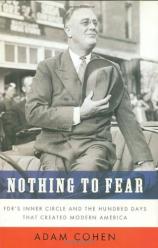Nothing to Fear: FDR’s Inner Circle and the Hundred Days That Created Modern America
Review
Nothing to Fear: FDR’s Inner Circle and the Hundred Days That Created Modern America
When Barack Obama sits down at his desk in the Oval Office on
January 20th, it would be comforting if he could reach into a
drawer and pull out an owner’s manual that would tell him
exactly what he needs to do to address the seemingly intractable
array of problems that will confront him from his first day in
office. Knowing that imaginary manual won’t be there, a
reasonable substitute might be Adam Cohen’s engrossing
account of the remarkable team of advisors who helped Franklin
Delano Roosevelt secure his place as one of our greatest
presidents.
By now, most of us experience a certain numbness when we hear
that America is in the midst of “The Worst Economic Crisis
Since the Great Depression.” Some perspective clearly is in
order, and Cohen, assistant editorial page editor of the New
York Times, offers it in a work that combines impressive
historical scholarship with narrative verve. When Roosevelt took
office on March 4, 1933, somewhere between one-quarter and
one-third of the workforce was unemployed, the stock market had
tumbled 85 percent since the crash in October 1929, and major
industries like automobiles and steel were operating at a small
fraction of their capacity. Tens of thousands of malnourished
Americans were living in “Hoovervilles,” named for the
president whose stubborn refusal to abandon the verities of free
market capitalism had caused the economy to spiral down into a
crisis so dire that, Cohen opines, “the nation would be lost
to revolution or complete economic collapse if things did not
improve quickly.”
Cohen’s account of the early days of Roosevelt's New Deal
is not focused on the man himself, but instead on a group of five
extraordinary advisors who spearheaded the fight for the hodgepodge
of legislation that comprised the work of the Hundred Days: Raymond
Moley; budget director Lewis Douglas; Frances Perkins, secretary of
labor; Henry Wallace, secretary of agriculture; and the federal
relief administrator, Harry Hopkins. This fivesome, according to
Cohen, were “the people who, by virtue of their jobs,
talents, rapport with the president, and force of personality, were
able to leave the greatest mark.”
Cohen argues that Roosevelt took office without any overarching
ideology or even a fully coherent program to deal with the economic
catastrophe. Rather than embodying Roosevelt’s
“carefully planned response to the crisis,” he writes,
the real story of the Hundred Days “is more complicated and
more chaotic.” Indeed, within FDR's own inner circle, the
often acrimonious debates pitted Lewis Douglas, who favored cutting
government spending and balancing the budget, against Frances
Perkins, the first female cabinet secretary and an advocate of
massive public works spending. What was most extraordinary about
the attack on the Great Depression, especially when contrasted to
the corporate groupthink that has marked the Bush years, is the
atmosphere of combative intellectual ferment that characterized
Roosevelt’s presidency.
His unorthodox management style, for example, sometimes involved
giving the same assignment to two staffers without telling either
of the other’s task and then letting them thrash out their
differences when they returned with competing recommendations.
Cohen does a masterful job conveying both the passion people like
Perkins and Wallace (along with Hopkins, who did not arrive until
the Hundred Days almost were at an end, his favorites among the
inner circle) brought to their jobs and the improvised, often
audacious, quality of the solutions they championed.
In the space of just over three months, the Roosevelt
administration pushed through 15 pieces of major legislation, from
the Civilian Conservation Corps, to the Agricultural Adjustment
Act, to the National Industrial Recovery Act. People began to
return to work (although the unemployment rate lingered at 14
percent as late as 1937), and commodity prices, which had dropped
as much as 50 percent, stabilized. The flood of new laws was not
without its critics --- the right attacked the dramatic expansion
of government power, darkly hinting at its autocratic overtones,
while the left castigated Roosevelt for what it perceived as half
measures. Years later, the Supreme Court struck down the AAA and
NIRA. Ironically, even two of the five advisors Cohen profiles,
Moley and Douglas, became virulent critics of the New Deal after
leaving Roosevelt’s side.
In Adam Cohen’s sympathetic view, the Hundred Days, along
with Washington’s transformation of the colonies into a
constitutional republic and Lincoln’s preservation of the
union, stands as the “third great revolution in American
history.” As he demonstrates in this accomplished work of
popular history, Roosevelt and his thoroughly pragmatic team of
counselors laid the foundation of modern activist government. And
now we all get to watch, as the ability of that kind of government
to solve serious problems soon will be tested anew.
Reviewed by Harvey Freedenberg (mwn52@aol.com) on January 13, 2011
Nothing to Fear: FDR’s Inner Circle and the Hundred Days That Created Modern America
- Publication Date: January 8, 2009
- Genres: History, Nonfiction
- Hardcover: 384 pages
- Publisher: Penguin Press HC, The
- ISBN-10: 159420196X
- ISBN-13: 9781594201967




